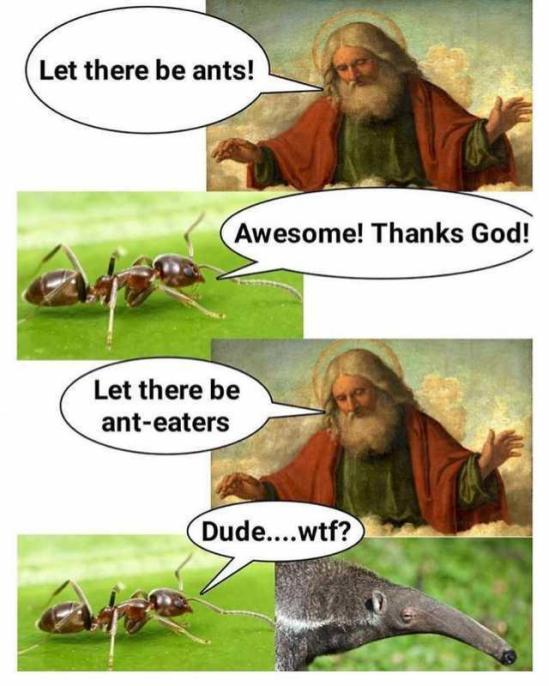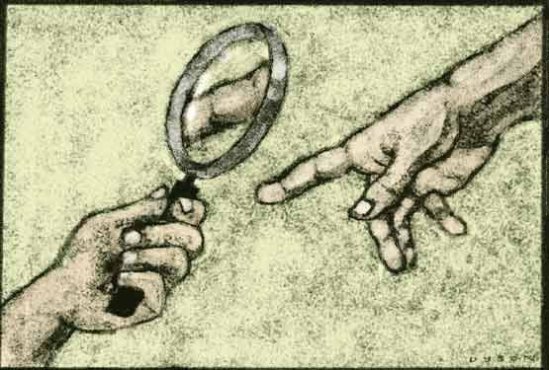This post will look at how creationism and Intelligent Design falls short when it comes to the question of suffering. In my mind, the question of suffering is one of the most fundamental questions in theology.
What makes the creationism and Intelligent Design most problematic in a theological sense is the question of suffering. Within the Christian tradition, there is no place for a kind of demiurge or designer other than God. Thus, the only Creator or Intelligent Designer could be the Christian God. In order for God to create by means of evolution, it follows that God would use “the suffering of very many creatures.” The question then follows: If God can intervene to introduce certain elements of complexity, why could God not intervene in the suffering of a myriad of creatures? The philosopher David Hume was brutally direct in stating the problem: “Is he [God] willing to prevent evil, but not able? Then he is impotent. Is he able, but not willing? Then he is malevolent. Is he both able and willing? Whence then evil?” Michael Ruse makes a similar point:
Many vile afflictions are caused by minor changes at the molecular level. The effects multiply, bringing on lifelong pain and suffering. If the designer is around to make the very complex, why doesn’t he take a little time to repair the simple but broken? Either he cannot, in which case wonders how powerful he really is and if he truly has designed the very complex; or he does not, in which case one wonders about his intentions toward the world of life, including humans. Either way, the designer seems not to be something that can be identified with the Christian God, which is the underlying aim of the Intelligent Design theorists.
Biologist Robert Pollack points out that Intelligent Design reduces the suffering in this world to “but a preamble for a world to come, in which a totally new Intelligent Design will provide all the solace, peace, and love of which nature seems so severely depleted.” This reduction does not provide satisfactory answers to the question of suffering. Pollack goes on to say that this view keeps us from acting to do good in the world:
This is why as an article of faith, ‘intelligent design’ is truly powerful, and deeply troubling. As science, it is meaningless: nothing in nature supports it; nothing in nature demands it; nothing we can do will either prove or disprove it. But as a belief, it distracts us from all acts that we – as individuals but more important as families, faiths, nations, and even as a species – can perform in this world, to diminish the catastrophic consequences of natural disasters and human cruelties.
A famous example of the problem of suffering and Intelligent Design is the ichneumonidae wasps that lay their eggs in a living caterpillar. In South Africa there are four genii of the family Ichneumonidae. Osprynchotus species parasite the nests of other wasp species that build nests with mud. Enicospilus species parasite the larvae of noctuid moths. Gabunia species parasite the larvae of long-horn beetles (family Cerambycidae). Theronia species parasitize the larvae and pupae of Lepidoptera (moths and butterflies), Coleoptera (beetles), Diptera (flies), Hymenoptera (sawflies, wasps, and bees), and Neuroptera (lacewings and antlions). Charles Darwin referred to this specific instance of endoparasitism in a letter to his friend Asa Gray: “There seems to be too much misery in the world. I cannot persuade myself that a beneficent and omnipotent God would have designedly created the Ichneumonidae with the express intention of their feeding within the living bodies of Caterpillars…”
I have been (un)fortunate enough to witness the eruption of parasitic wasp larvae (Apanteles acraea from the family Braconidae) with my own eyes. The wasp larvae eat the caterpillar from the inside until they are ready for pupation, at which moment they eat their way out of the still living caterpillar and begin spinning their cocoons on the surface. I have recently began the hobby of caterpillar rearing, where one rears caterpillars, documenting their life history, and then send the results off to a lepidopterist for research. It is an interesting and mostly rewarding hobby with the added value that it benefits science. A cucullia inaequalis caterpillar that I was busy rearing had been parasited without my knowledge and great was the shock when I checked up on it only to find a large number of writhing wasp larvae that were starting to spin their cocoons on the outside of the caterpillar. Their poor host was alive and not paralysed throughout the entire ordeal. You can view the video here and see a photo album here. After they had spun their cocoons, the caterpillar somehow got itself free from under them and started walking around with gaping holes in its soft body. It died a few hours later.

The Pteromalus puparum wasps from the family Pteromalidae parasite final instar caterpillars and then live and pupate within the larva and pupal form of the butterfly or moth. The adult wasp then emerges from the pupa via a small exit hole. Parasitism is almost never immediately fatal to the host, because the parasite requires the host to be alive for as long as it is needed. Most parasite species are highly specialised.
The biologist David Hull states that “The God of the Galapagos is careless, wasteful, indifferent, almost diabolical. He is certainly not the sort of God to whom anyone would be inclined to pray.” This is the kind of God that can be deduced from evolution, which, as Hull describes, is “rife with happenstance, contingency, incredible waste, death, pain and horror…” David H Bailey adds to this, pointing out the difficulties of creationism and Intelligent Design when it comes to “the many troublesome features of nature, such as pain, disease, violence, and the millions of species that have become extinct.”
The Catholic biologist Francisco Ayala states that “As floods and drought were a necessary consequence of the fabric of the physical world, predators and parasites, dysfunctions and diseases were a consequence of the evolution of life. They were not a result of deficient or malevolent design.” Ayala also states that “I do not attribute all this misery, cruelty, and destruction to the specific design of the Creator. … I rather see it as a consequence of the clumsy ways of the evolutionary process.” He claims that it will be good for people who have faith to accept natural selection as being responsible for “the design of organisms, as well as for the dysfunctions, oddities, cruelties, and sadism that pervade the world of life.”
Conclusion
From the previous sections it can be seen that, theologically speaking, creationism and Intelligent Design has certain pitfalls. The two main pitfalls are dishonesty on the part of God and the problem of suffering, which weighs the heavier of the two. The dubious use of the Bible is also a point of concern and the bad science coupled with bad theology is a pock mark on the face of Christianity.
Also See:
10 Astonishing Examples of Bizarre Parasitic Life Cycles
10 Disturbingly Weird Parasites

And now something light-hearted…

Sources:
Ayala, F J. 2009. Charles Darwin: Friend or foe? Word & World 29/1, 19-29.
Daintith, J & Martin, E. (eds.) 2010. Oxford dictionary of science. Oxford: Oxford University Press.
Darwin, F. (ed). 1898. The life and letters of Charles Darwin. Vol I. New York: D Appleton and Company.
Griffiths, C, Picker, M & Weaving, A. 2004. Field guide to insects of South Africa. Cape Town: Struik Nature.
Pollack, R. 2007. “Intelligent Design,” natural design, and the problem of meaning in the natural world. Crosscurrents, 125-135.
Ruse, M. 2006. Darwinism and its discontents. New York: Cambridge University Press.
Southgate, C. 2008 The groaning of creation: God, evolution, and the problem of evil. London: Westminster John Knox Press.







